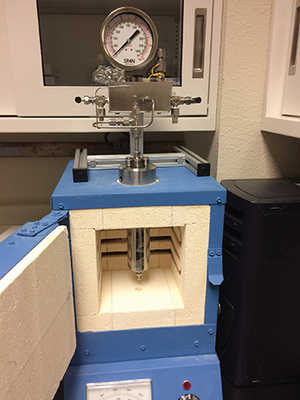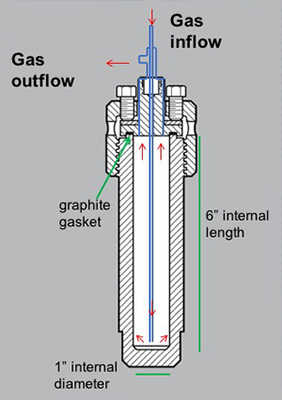Background
 Figure 1: Our completed set-up includes a reaction vessel with inert coating, which is shown here suspended in the oven.
Figure 1: Our completed set-up includes a reaction vessel with inert coating, which is shown here suspended in the oven. The goals of this project are twofold. First, we aim to develop a laboratory set-up for hydrothermal experiments on geologic samples. Second, we will utilize that set-up to characterize volatile production during thermal decomposition of complex, kerogen-like organics that may be abundant in the interiors of icy satellites and other solid bodies in the outer solar system. Many of these bodies are hypothesized to have liquid oceans underneath their icy shells, including Europa, Titan, and Enceladus. Titan also has a thick atmosphere composed primarily of nitrogen and methane, and liquid seas of hydrocarbons. The volatile cycles of these bodies may include input via outgassing from their rocky cores; this idea is supported by evidence for hydrothermal vents on Enceladus’ ocean floor, the presence of outgassed 40Ar in Titan’s atmosphere, and the importance of outgassing to terrestrial volatile cycles. Constraining what volatiles may be produced in the rocky cores of these bodies is therefore key to understanding their volatile cycles and their potential habitability. Our experiments will provide new insight into volatile chemistry in the interiors of these bodies, where radioactive decay and accretional and tidal heating may lead to decomposition of complex organics.
Approach
 Figure 2: The reaction vessel has an internal volume of 75 mL. The inlet and outlet have been specially designed to allow flow through of carrier gases to collect the product gases.
Figure 2: The reaction vessel has an internal volume of 75 mL. The inlet and outlet have been specially designed to allow flow through of carrier gases to collect the product gases. Our experimental set-up includes a 75mL Ni alloy vessel that is rated to 1,000 psi at 850°C with an inert coating with a built-in thermocouple to monitor the vessel temperature. Gases evolved during heating experiments will be captured and measured via a combination of gas chromatography-thermal conductivity detector (TCD) and state-of-the-art gas chromatography-mass spectrometry (GC-MS). Our target sample is an organic-rich meteorite that has been characterized extensively in the literature. This meteorite preserves the chemistry of planetary building blocks, including the icy satellites. The complex material that comprises the majority of the meteorite organics is similar to organics observed in primitive outer solar system building blocks like comets, and the meteorite is therefore a good analog for the satellite interior material. We will heat aliquots of the sample to a range of temperature conditions relevant to satellite interiors, and then collect and characterize the product gases.
Accomplishments
Our reaction vessel set-up is complete, and we are in the process of characterizing it, including temperature calibration, identification of the background compounds, determination of the degree of surface inertness, and accurate measurement of the internal volume. The system is capable of internal temperatures up to ~800°C, while maintaining an external temperature above the oven of <100°C. The vessel has two removable sample holder blocks to reduce the internal volume and enhance the concentration of product gases. The surface coating prevents catalysis during high-temperature experiments. The system also features automatic temperature logging every 5 seconds. Product gases will be collected via flow through of an inert carrier gas, after which they will be analyzed using TCD and GC-MS, with the capability to detect most light gases present at ppb levels or higher.
